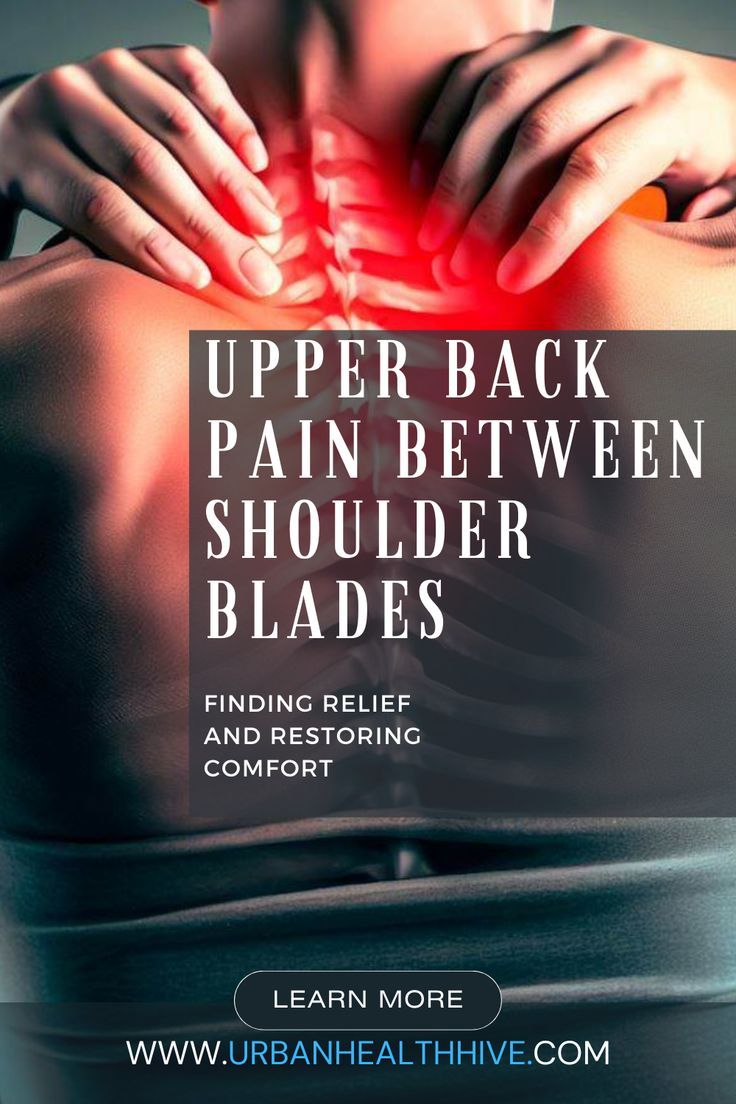As someone who has personally experienced upper back pain between the shoulder blades, I understand the discomfort and frustration it can cause. Many individuals, including myself, have dealt with this type of pain at some point in their lives. In this article, I aim to provide helpful suggestions and reasons for finding relief from upper back pain between the shoulder blades. Let’s explore some common causes of this pain and effective self-care strategies to alleviate it.
Causes of Upper Back Pain Between Shoulder Blades
Poor Posture and Sedentary Lifestyle
Poor posture and spending prolonged hours in a sedentary position, such as sitting at a desk, can contribute to upper back pain. Slouching or hunching forward places strain on the muscles between the shoulder blades. To improve posture, consciously sit or stand tall, pull the shoulders back, and engage the core muscles. Regular breaks to stretch and walk around can also help reduce the impact of a sedentary lifestyle.
Muscle Strain and Tension
Muscle strain and tension in the upper back can result from activities that require repetitive motions, lifting heavy objects or performing
deadlifts, or sudden movements. Stress and emotional factors can also lead to muscle tension, exacerbating the pain. Stretching exercises targeted at the upper back muscles, such as the rhomboids and trapezius, can help alleviate tension and promote relaxation.
Overuse and Repetitive Movements
Engaging in repetitive movements or actions, particularly without proper form or ergonomics, can strain the muscles between the shoulder blades. If your work or hobbies involve repetitive motions, it’s essential to take frequent breaks, practice proper ergonomics, and vary your movements to avoid overuse and strain.
Trauma or Injury
Accidents or traumatic events, such as falls or sports injuries, can cause upper back pain between the shoulder blades. If you have experienced trauma or suspect an injury, it is important to seek medical attention for a proper diagnosis and appropriate treatment.
Stress and Emotional Factors
Emotional stress and tension can manifest physically as pain in the upper back. Stress management techniques, such as deep breathing exercises, meditation, or engaging in activities that promote relaxation, can help reduce muscle tension and alleviate pain.
Home Remedies and Self-Care Strategies
Stretching Exercises for Upper Back Pain
Perform gentle stretching exercises to improve flexibility and relieve tension in the muscles between the shoulder blades. Some effective stretches include the doorway stretch, shoulder rolls, and cat-cow stretch. Hold each stretch for about 30 seconds and repeat several times throughout the day.
Strengthening Exercises for Upper Back Muscles
Strengthening the muscles in the upper back can provide support and stability, reducing the risk of pain and injury. Exercises such as rows, reverse flyes, and scapular squeezes can help strengthen the rhomboids and trapezius muscles. Start with light weights or resistance bands and gradually increase intensity as your strength improves.
Heat and Cold Therapy
Applying heat or cold packs to the affected area can help alleviate pain and reduce inflammation. Use a heating pad, warm towel, or hot water bottle for heat therapy. For cold therapy, wrap an ice pack in a towel and apply it to the upper back for about 15 minutes. Alternate between heat and cold therapy for maximum relief.
Relaxation Techniques and Stress in Management
Engage in relaxation techniques to reduce stress and tension in the upper back. Deep breathing exercises, meditation, yoga, or gentle activities like taking a warm bath can promote relaxation and ease muscle tension. Find a method that works best for you and incorporate it into your daily routine.
Ergonomic Adjustments
Make ergonomic adjustments to your workspace and daily activities to minimize strain on the upper back. Ensure that your chair provides proper support for your back, and adjust the height and positioning of your desk and computer monitor to maintain a neutral posture. Use a supportive pillow and mattress while sleeping to promote spinal alignment.
Postural Awareness and Corrective Exercises
Develop postural awareness and practice corrective exercises to improve your posture and reduce upper back pain. Pay attention to your body alignment throughout the day, and make adjustments as needed. Exercises such as wall angels, shoulder retractions, and chest stretches can help correct postural imbalances and relieve pain.
Massage and Manual Therapy
Consider seeking professional massage therapy or manual therapy sessions to address upper back pain. Skilled therapists can target specific muscles and release tension through various techniques, such as deep tissue massage or trigger point therapy. Regular sessions can provide relief and promote overall relaxation.
Maintain a Healthy Lifestyle
A healthy lifestyle can contribute to overall well-being and reduce the risk of upper back pain. Maintain a balanced diet, engage in regular exercise, and stay hydrated. A healthy weight and strong muscles can support the spine and minimize strain on the upper back.
Conclusion
Upper back pain between the shoulder blades can be a disruptive and uncomfortable experience. By understanding the potential causes and implementing self-care strategies, you can find relief and restore comfort.
Remember to prioritize good posture, incorporate stretching and strengthening exercises, and manage stress effectively. If the pain persists or worsens, it is important to consult a healthcare professional for a thorough evaluation and appropriate treatment.
FAQs
1. Can stress and emotional factors contribute to upper back pain between the shoulder blades?
Yes, stress and emotional tension can manifest as physical pain in the upper back. Practicing stress management techniques and engaging in relaxation activities can help alleviate muscle tension and reduce pain.
2. Are there any specific exercises to target the muscles between the shoulder blades?
Yes, exercises such as rows, reverse flyes, and scapular squeezes can target the muscles between the shoulder blades, specifically the rhomboids and trapezius. These exercises help strengthen the upper back muscles and provide support.
3. How long should I hold a stretching exercise for the upper back?
It is recommended to hold each stretch for about 30 seconds and repeat several times throughout the day. Be mindful of your body’s response and adjust the duration or intensity of the stretch accordingly.
4. Is it necessary to seek medical attention for upper back pain between the shoulder blades?
If the pain persists or is accompanied by other concerning symptoms, it is advisable to consult a healthcare professional for a proper diagnosis and appropriate treatment.
5. Can ergonomic adjustments help alleviate upper back pain?
Yes, making ergonomic adjustments to your workspace and daily activities can help minimize strain on the upper back. Ensure that your chair provides proper support and maintain a neutral posture while working.
Remember, taking proactive steps towards self-care and seeking professional guidance when needed can greatly contribute to managing and alleviating upper back pain between the shoulder blades. Prioritize your well-being and make positive changes to restore comfort and enjoy a pain-free life.

![Urban Health Hive]](https://urbanhealthhive.com/wp-content/uploads/2023/05/cropped-cropped-Health_Logo.png)



